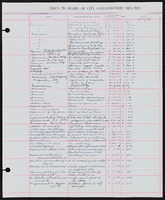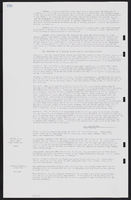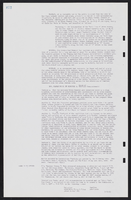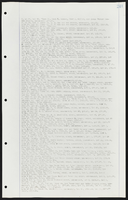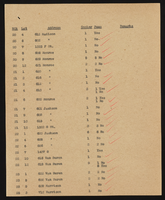Search the Special Collections and Archives Portal
Search Results
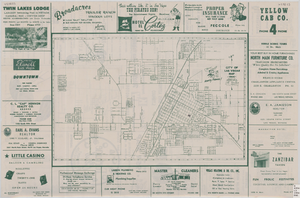
Street map of the city of Las Vegas, 1954
Date
1954
Description
22 x 34 cm. on sheet 36 x 54 cm. Copyright held by Redwood Publishing Co. Includes advertisements. 1954 [ed.] Street index, map of the Strip and advertisements on verso. Map is irregularly shaped. Original publisher: Redwood Pub. Co..
Image
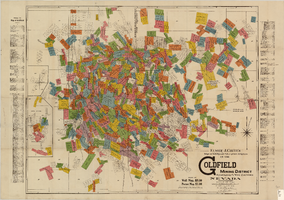
Elmer J. Chute's map of U.S. patent and location surveys in the Goldfield Mining District, Esmeralda and Nye Counties (Nev.), 1907
Date
1907
Description
Scale [ca. 1:22,800. 1 in. to approx. 1900 feet] ; 1 map : col. ; 66 x 82 cm., folded to 18 x 9 cm ; Includes index Includes township and range grid ;
Image
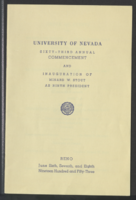
University of Nevada (Reno) 63rd commencement program
Date
1953-06-06 to 1953-06-08
Archival Collection
Description
Commencement program from University of Nevada, Las Vegas Commencement Programs and Graduation Lists (UA-00115).
Text

Transcript of interview with Robert Ambrose by David G. Schwartz, September 28, 2016
Date
2016-09-28
Archival Collection
Description
Robert Ambrose started in the gaming industry as a slot attendant at the Tropicana Atlantic City in 1985. After three years in that role, Ambrose was promoted to supervisor, a position he held for an additional five years before being promoted again to shift manager at the same property. He would eventually move into the position of executive director of slots and marketing operations which he held until he left the Tropicana in 2007. Ambrose went on to write for Casino Enterprise Management before helping to build and open Indiana Live! in Indiana. He later joined Drexel University to assist in building their gaming program and training lab. Ambrose is currently an instructor in the Center for Hospitality & Sport Management at Drexel and also writes for Casino Life magazine. The interview with Ambrose begins with his discussion of the various roles and duties of the different positions he held at Tropicana Atlantic City. He mentions some of the mentors he has had throughout his career and some of the important skills and approaches in slot management that they taught him. Ambrose then describes what he believes are the qualities of both good and bad slot managers before explaining his philosophy on what makes a good slot floor as well. He also provides details of his experience in building and opening a casino with the late Dennis Gomes and Cordish Gaming. He then discusses his experiences and interactions with slot vendors before describing how he believes slot operations has changed since he started in the industry, specifically considering changes in technology and the use of free play. Ambrose provides his opinion on the future of slots, particularly with skill-based gaming and eSports, and he answers the question of whether he gambles. Ambrose finalizes the interview by providing his advice to young people who want to eventually work in the slot industry.
Text

Transcript of interview with Mike Gausling by David G. Schwartz, December 7, 2016
Date
2016-12-07
Archival Collection
Description
Mike Gausling started in the casino industry as a slot floor person at the Aladdin in 1976. After about a year, he moved to the Stardust in a similar capacity and in 1980 went to the the Sundance, later named Fitzgeralds and The D Las Vegas. Gausling later worked at the Holiday Casino where he held supervisory roles and then after about 12 years in those roles, eventually assisted in opening the Stratosphere. He would then move to The Mirage where he would start on the floor again before moving into higher positions at that property. Gausling later went to Green Valley Ranch Resort where he currently holds the position of slot guest service supervisor. Mike Gausling’s interview begins with his discussion of the various roles in slot operations he has held over the past 40 years. After describing the various positions and properties at which he worked, Gausling provides his thoughts on what makes both good and bad slot managers. He then discusses his experiences in interacting with customers and what his philosophy is on what casino guests want in playing slots. Gausling also discusses the differences between local casino properties and those on the Las Vegas Strip, and he describes his work in opening Green Valley Ranch. The interview continues with Gausling’s opinion on the impact of technology and free play as some of the biggest changes in the slot industry, and he later describes how a slot floor should be laid out. He also discusses how he thinks the future of slot machines will look like, particularly with skill-based gaming, and he also mentions his personal gambling preferences. The interview concludes with Gausling’s advice to young people who want to go into slot operations as a career.
Text
Pagination
Refine my results
Content Type
Creator or Contributor
Subject
Archival Collection
Digital Project
Resource Type
Year
Material Type
Place
Language
Records Classification

